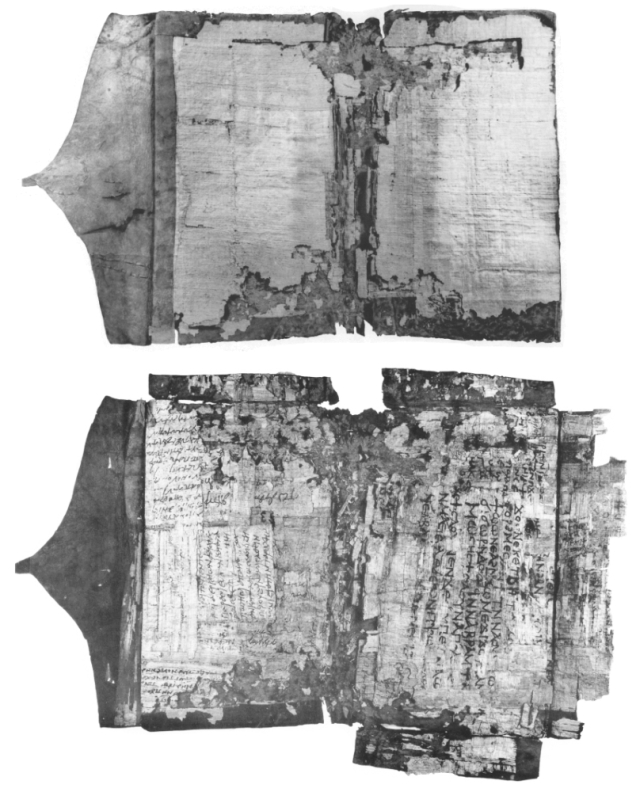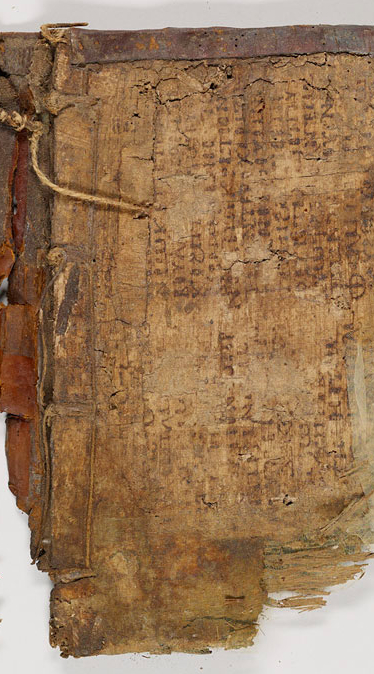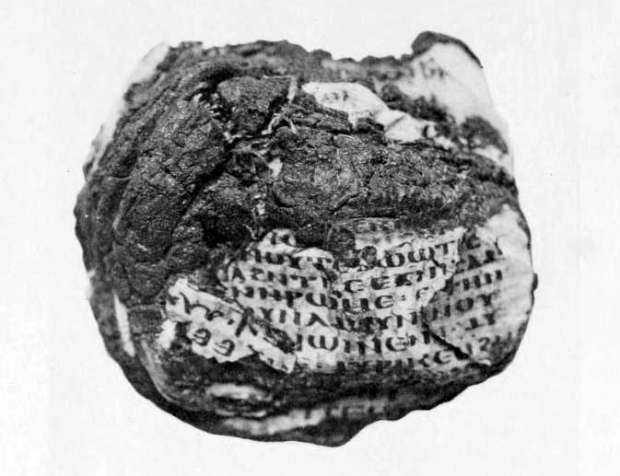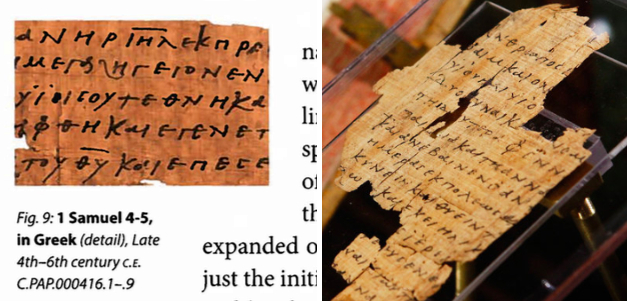Thanks to Matthew Hamilton for pointing out that the Green Collection papyrus containing 1 Samuel was described in the catalog accompanying the “Passages” exhibition in 2012. Matthew states that in the catalog, “the papyrus is noted as having 9 chapters [and] is dated to the early 3rd century AD.” Thus, it seems clear that in the video I mentioned in my previous post, Scott Carroll really was talking about “chapters” of the book being extracted from mummy cartonnage. Even more interesting is Matthew’s note that, according to the “Passages” catalog, the papyrus “had been pressed and sewn together and recycled for domestic use.” Matthew also added that the catalog includes an image of “what appears to be the same fragments when the cartonnage was only partially dismantled.” He was kind enough to share a scan of this image:

Papyrus clump with leaf of 1 Samuel 1:1-5 showing; image source: Scott Th. Carroll, Passages: The Experience. The 400th Anniversary of the King James Bible. Exhibition Guide (Marion, Indiana: Triangle Publishing, 2012), p. 4
I have to admit, I’m not sure what to make of this. The circular shape is striking. Matthew observes: “Looks like there is the ongoing mix up of mummy cartonnage and non-mummy cartonnage.” Yes, this doesn’t look like a typical mummy mask or casing. I don’t know exactly what is meant in the catalog entry by the phrase “pressed and sewn together and recycled for domestic use.” Which “domestic” use? When Dirk Obbink used that same term to describe the source of the Sappho papyrus (after originally identifying the source as a mummy cartonnage), he implied that it included book covers: “…probably domestic or industrial cartonnage: it might have been employed e.g. for a book-cover or book-binding.” When it comes to book covers composed of waste papyrus, the most familiar pieces are probably the Nag Hammadi covers:

Cover of Nag Hammadi Codex VII before and after removal of end papers; image source: The Facsimile Edition of the Nag Hammadi Codices: Codex VII (Brill, 1972), pp. 3-4
The leather covers of other single-quire codices have a similar look, with overlapping layers of scrap papyrus of varying sizes. Here is an image of the inside of the cover of the Berlin Coptic Proverbs codex (Staatsbibliothek zu Berlin, Ms. or. oct. 987, LDAB 107968):

Image source: Hans H. Bockwitz, “Zur Geschichte von Karton und Pappe im Zeitalter der Handpapiermacherei,” in Karton im Wandel der Zeit (Hillegossen, 1951), p. 12.
Aside from the strange circular shape of the 1 Samuel clump, the other interesting feature is the threads. The presence and placement of threads (especially those in the upper left corner) remind me a bit of the covers of some later multi-quire codices in which the covers were sewn directly to the book block. There are several such boards in, for example, the Morgan collection:

Cover of MS M.587 in the Morgan Library; image source: Morgan Library
Another possibility is that the 1 Samuel clump is simply the compressed remains of a codex (that is to say, perhaps it was never part of a cover and not at all “cartonnage” in any sense of the word). The remains of ancient codices can look pretty terrible before they are properly conserved. Here is an image of the Freer Coptic Psalter (a parchment book, LDAB 107936) before the leaves were separated and conserved:

Freer Coptic Psalter before conservation; image source: Willam H. Worrell, The Coptic Psalter in the Freer Collection (London: Macmillan, 1916), plate I.A
So, recall that in the video, Carroll mentioned that “underneath” the text of 1 Samuel, he found “Homer’s Iliad.” It makes me wonder: What passages of the Iliad were “underneath” the leaves of 1 Samuel? Were the Iliad fragments also in codex format? Might it be a single codex that contained excerpts of 1 Samuel and the Iliad? (There’s precedent for such “mixed” codices in the form of P.Bodmer XLV+XLVI+XLVII+XXVII, the Bodmer codex containing parts of Susanna, Daniel, and book 6 of Thucydides.)
To sort out these kinds of questions, we would need to know exactly how the threads passed through the leaves in the papyrus clump. Let us hope that there was detailed documentation of the whole separation process and that it was carried out under the watchful eye of an experienced conservator and an expert on ancient bookbinding (and not, say, on the kitchen stove while watching a football game).
In the scanned pages I saw from the “Passages” catalog, there was no information about provenance. When I was in Rome in 2014, I picked up the catalog accompanying the “Verbum Domini II” exhibition that Roberta Mazza mentioned in the comments to my earlier post. A papyrus fragment of 1 Samuel (GC.PAP.000416.1-.9) was also part of that exhibition:
 The small photo in the catalog shows 1 Samuel 4:17 and does look like the same hand as the fragment containing 1 Samuel 1:1-5 that was on display in the Passages exhibit:
The small photo in the catalog shows 1 Samuel 4:17 and does look like the same hand as the fragment containing 1 Samuel 1:1-5 that was on display in the Passages exhibit:

Papyri of 1 Samuel from the Verbum Domini II exhibit (left) and the Passages exhibit (right); image sources: David Trobisch et al., Verbum Domini II: God’s Word Goes Out to the Nations (Washington, D.C.: Museum of the Bible, 2014), p. 18 and The Oklahoman
And as Roberta noted, the “Verbum Domini” catalog also confirms that the papyrus of 1 Samuel is indeed in the codex format. This is not surprising, given the (new) dates that these pieces are assigned in this catalog, late 4th-5th century CE in the heading and late 4th-6th century CE in the caption to the photo.
But again, the “Verbum Domini” catalog doesn’t provide any information about provenance, so the most pressing question remains: Where did it come from?

It may be prudent to revisit the 34 page document that Josh McDowell posted in December 2013 after working with Carroll to extract literary papyri.
Click to access Bibliographical-Test-Update-08.13.14.pdf
This PDF is full of many errors and shows McDowell’s incompetence in this area, but several interesting insights can be gleaned. One such insight is that Carroll extracts papyri from four sources – What he calls:
1. manuscript cartonnage
2. papyrus plates
3. Coptic burial rolls
4. mummy burial masks
So while Carroll predominantly talks about the destruction of mummy burial masks in interviews, probably for dramatic effect, he was apparently dissecting a wider range of materials. Could 1 Samuel be from a “burial roll”?
Also notable, in a April 2011 interview (before the world-premiere of Passages in Oklahoma City) he states, “We have developed a process of preserving the art [of a mask] while extracting the infrastructure…A professor from Oxford and I have extracted a lost work of Aristotle, other classical works, and very early unrepresented texts of Scripture” (p. 8). One could presume that he’s referring to Obbink here.
Thanks, David. Can someone enlighten me on what exactly is meant by “Coptic burial roll”? This is not something I have ever heard of. The google is not helping me: https://www.urbandictionary.com/define.php?term=Burial%20roll
I couldn’t find anything either and would like to be enlightened.
Played around with the words “Coptic burial roll”, using synonyms and also translating into French and German – and have a possible hit.
At the website for Apolonia Ancient Art is an item listed as “X-Rare Coptic Papyrus Burial Scroll with Text” with photographs. I don’t know any details about that item other than what is on the website
http://www.apoloniagallery.com/items/1004874/Rare-Coptic-Papyrus-Burial-Scroll-Text
I had some success searching for the terms Egyptian funerary headrest/pillow. According to some sources, these headrests/pillows seem to have been used as a type of amulet. Perhaps some Egyptian Christians were buried with rolled up biblical books under his/her head for good luck moving into the afterlife? Additionally, could this in some way be connected to the Hawara Homer found by Flinders Petrie? The Hawara Homer was also found rolled up under the head of a mummy? Perhaps Carroll and Obbink were finding Christian texts in these artifacts and passing them onto the MOTB. It also fits the time frame – the second century.
Harry Gamble (Books and Readers in the Early Church p. 266) wrote “Frederic G. Kenyon, who mentions that there are examples of very long scrolls in Egypt (over 30 m), but as they were all ceremonial burial scrolls, they were not meant to be read.” Kenyon Books and Readers in Ancient Greece and Rome, 1932, 51-52) refers mostly to copies of Book of the Dead. Art Treasures of the Vatikan (1975, fig. 396 is an example “A papyrus burial scroll.”) Mathew’s find of apolonia gallery is not quite clear or persuasive, nor the previous (same?) lot 138 in
http://catalogue.gazette-drouot.com/pdf/berge/archeologie/26052011/Berge-26052011-bd.pdf?id=8955&cp=32
By the way, a term that has more than one definition:
Opistograph. Apparently there are two definitions current. William A. Johnson, Books and Scribes in Oxyrhynchus (2004, p. 342): “Opistograph. A bookroll where the text is written on both front (recto) and back (verso). This term does not apply when both sides are written upon because the papyrus has been reused.” The Oxford English Dictionary entry, spelled opisthograph, does not include the limitation in the second sentence; nor does it limit to writing on papyrus. Examples of the broader use, including papyrus and skin, and in cases of Qumran mss where the second writing is from a second, later scribe are found in, e.g., Michael O. Wise, Thunder in Gemini (1994) and Emanuel Tov, Scribal practices and approaches reflected in the texts found in the Judean desert (2004).
Looks like the same object to me. On opisthographs, I prefer to follow Johnson’s distinction. Continuously copying a roll on both sides is a different kind of writing act from reusing the blank side of a roll for an unrelated text. The two types of artifacts should be distinguished.
Have you given thought to a Christian adaptation of a hypocephali? Françoise Dunand and Roger Lichtenberg write, “In tombs of the Graeco-Roman Period, we often find inscribed disks, called hypocephali, made of stuccoed cloth, papyrus, or bronze, placed under the head of the deceased (hence their name). See , Mummies and Death in Egypt, pg. 84.
I just don’t think these people know what they’re talking about for the most part. The examples headrests are all Demotic, not Coptic, and there doesn’t seem to be any evidence for this kind of thing involving papyrus in the Christian period.
You can see the necessity for the later date in phi, ypsilon, nu, the lambda in μεγαλη etc. The oblique angle shot is deceptive. Can’t think of another “domestic or industrial” use for this lump except as accretion of pastedowns for a book cover. But I guess one can always live in hope of learning something genuinely new, that doesn’t turn out to be hokum from a sideshow barker.
Reblogged this on Talmidimblogging.
Pingback: Another Book Biography: The Berlin Akhmimic Proverbs Codex | Variant Readings
Pingback: More on the Curious Green Collection 1 Samuel Papyrus | Variant Readings
Pingback: The Green Collection 1 Samuel: A Place of Purchase | Variant Readings